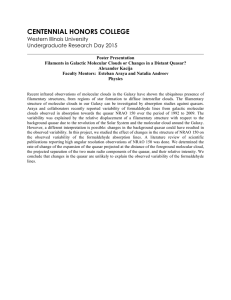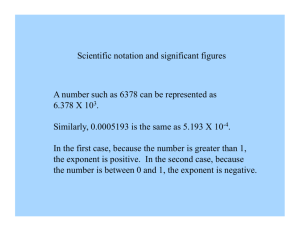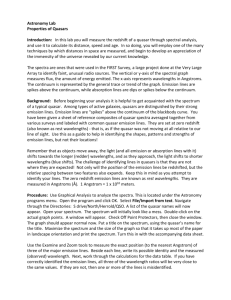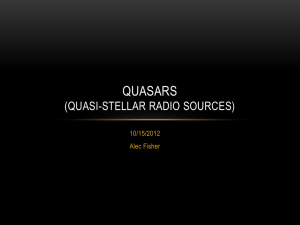THE SUDDEN DEATH OF THE NEAREST QUASAR Please share
advertisement
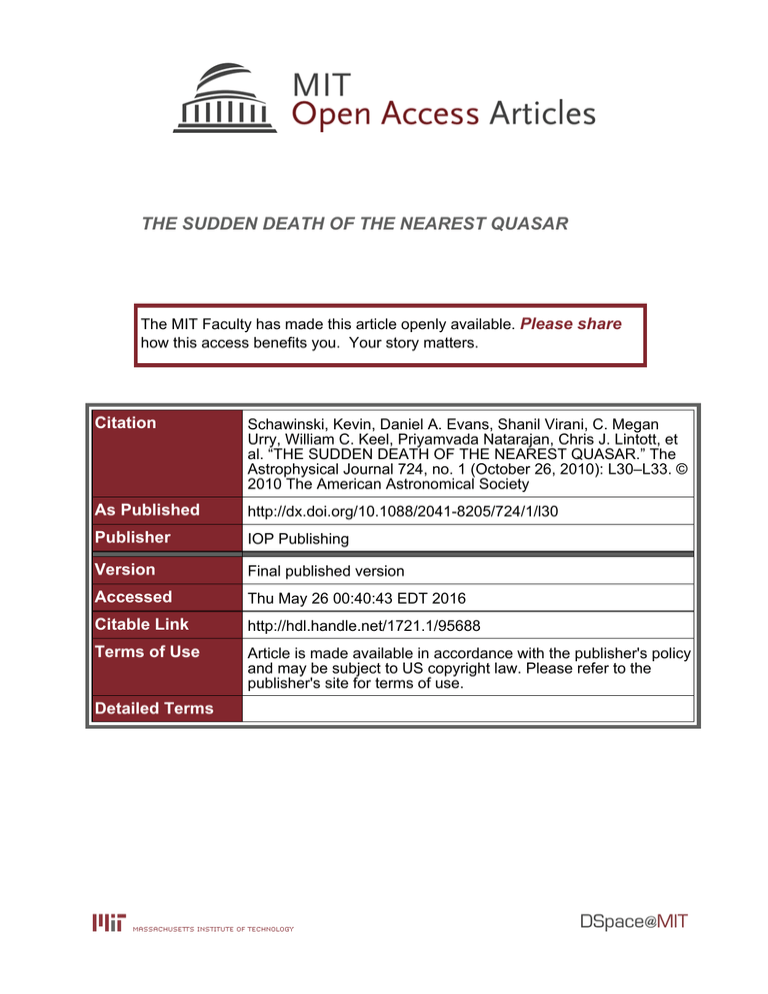
THE SUDDEN DEATH OF THE NEAREST QUASAR The MIT Faculty has made this article openly available. Please share how this access benefits you. Your story matters. Citation Schawinski, Kevin, Daniel A. Evans, Shanil Virani, C. Megan Urry, William C. Keel, Priyamvada Natarajan, Chris J. Lintott, et al. “THE SUDDEN DEATH OF THE NEAREST QUASAR.” The Astrophysical Journal 724, no. 1 (October 26, 2010): L30–L33. © 2010 The American Astronomical Society As Published http://dx.doi.org/10.1088/2041-8205/724/1/l30 Publisher IOP Publishing Version Final published version Accessed Thu May 26 00:40:43 EDT 2016 Citable Link http://hdl.handle.net/1721.1/95688 Terms of Use Article is made available in accordance with the publisher's policy and may be subject to US copyright law. Please refer to the publisher's site for terms of use. Detailed Terms The Astrophysical Journal Letters, 724:L30–L33, 2010 November 20 C 2010. doi:10.1088/2041-8205/724/1/L30 The American Astronomical Society. All rights reserved. Printed in the U.S.A. THE SUDDEN DEATH OF THE NEAREST QUASAR Kevin Schawinski1,2,18 , Daniel A. Evans3,4,5 , Shanil Virani1,2,6 , C. Megan Urry1,2,6 , William C. Keel7,19 , Priyamvada Natarajan1,2,6 , Chris J. Lintott8,9 , Anna Manning7,19 , Paolo Coppi1,2,6 , Sugata Kaviraj8,10 , Steven P. Bamford11 , Gyula I. G. Józsa12,13 , Michael Garrett12,14,15 , Hanny van Arkel12 , Pamela Gay16 , and Lucy Fortson17 1 Department of Physics, Yale University, New Haven, CT 06511, USA; kevin.schawinski@yale.edu Yale Center for Astronomy and Astrophysics, Yale University, P.O. Box 208121, New Haven, CT 06520, USA 3 Massachusetts Institute of Technology, Kavli Institute for Astrophysics and Space Research, 77 Massachusetts Avenue, Cambridge, MA 02139, USA 4 Harvard-Smithsonian Center for Astrophysics, 60 Garden Street, Cambridge, MA 02138, USA 5 Elon University, Elon, NC 27244, USA 6 Department of Astronomy, Yale University, New Haven, CT 06511, USA 7 Department of Physics and Astronomy, University of Alabama, P.O. Box 870324, Tuscaloosa, AL 35487, USA 8 Astrophysics Department, University of Oxford, Oxford OX1 3RH, UK 9 Adler Planetarium, 1300 S. Lakeshore Drive, Chicago, IL 60605, USA 10 Blackett Laboratory, Imperial College London, London SW7 2AZ, UK 11 Centre for Astronomy & Particle Theory, University of Nottingham, University Park, Nottingham NG7 2RD, UK 12 Netherlands Institute for Radio Astronomy, Postbus 2, 7990 AA Dwingeloo, The Netherlands 13 Argelander-Institut für Astronomie, Auf dem Hügel 71, 53121 Bonn, Germany 14 Leiden Observatory, University of Leiden, P.O. Box 9513, 2300 RA Leiden, The Netherlands 15 Centre for Astrophysics and Supercomputing, Swinburne University of Technology, Hawthorn, 3122 Victoria, Australia 16 Southern Illinois University, Edwardsville, IL 62026, USA 17 School of Physics and Astronomy, 116 Church Street S. E., University of Minnesota/Twin Cities, Minneapolis, MN 55455, USA Received 2010 August 24; accepted 2010 October 12; published 2010 October 26 2 ABSTRACT Galaxy formation is significantly modulated by energy output from supermassive black holes at the centers of galaxies which grow in highly efficient luminous quasar phases. The timescale on which black holes transition into and out of such phases is, however, unknown. We present the first measurement of the shutdown timescale for an individual quasar using X-ray observations of the nearby galaxy IC 2497, which hosted a luminous quasar no more than 70,000 years ago that is still seen as a light echo in “Hanny’s Voorwerp,” but whose present-day radiative output is lower by at least two, and more likely by over four, orders of magnitude. This extremely rapid shutdown provides new insight into the physics of accretion in supermassive black holes and may signal a transition of the accretion disk to a radiatively inefficient state. Key words: quasars: general – quasars: individual (IC 2497) Online-only material: color figures shocks (such as might be induced by a jet; Lintott et al. 2009). Radio observations of IC 2497 reveal a nuclear source and a jet hotspot in the nucleus, and a large kiloparsec-scale structure that may be a jet (Józsa et al. 2009; Rampadarath et al. 2010). The Voorwerp lies where this jet meets the Hi reservoir and coincides with a local decrement in atomic hydrogen presumably due to photoionization (see Figure 2 of Józsa et al. 2009). An actively accreting black hole at the center of IC 2497 is therefore the only plausible source of ionization that can account for the emission seen from the Voorwerp. The light-travel time from the nucleus of IC 2497 to the Voorwerp, accounting for all possible geometries, ranges from 45,000 to 70,000 years (Lintott et al. 2009) and so the Voorwerp reflects the radiative output of the central black hole of IC 2497 at those times in the past. Its large physical extent rules out a brief flare, caused, for example, by the tidal disruption of a star, as the ionizing source (Komossa et al. 2004; Gezari et al. 2006). The black hole must produce sufficient ionizing photons in order to power its observed [O iii] λ5007 luminosity. This requirement corresponds to 2 × 1045 erg s−1 between 1 and 4 Ryd (13.6–54.4 eV), assuming isotropic emission. This likely underestimates the necessary intrinsic luminosity due to large amounts of dust obscuration in the bulge of IC 2497, which has prominent dust lanes (Figure 1). We calculate the required luminosity of the quasar lighting up the Voorwerp 1. INTRODUCTION The discovery of the object known as “Hanny’s Voorwerp”20 (the Voorwerp hereafter) by a citizen scientist participating in the Galaxy Zoo project (Lintott et al. 2008, 2009) permits the first direct probe of a quasar’s variability for an individual source on timescales significantly longer than human lifetimes (Lintott et al. 2009). The Voorwerp is a large (11 × 16 kpc) cloud of ionized gas 45,000–70,000 lt-yr away from the nucleus of the galaxy IC 2497, embedded in a larger reservoir of atomic hydrogen (Józsa et al. 2009), with a mass of several times 109 M (see Figure 1). The optical spectrum of the Voorwerp is dominated by a powerful [O iii] λ5007 emission line and shows little detectable continuum. The presence of other emission lines with high ionization potentials, such as [He ii] and [Ne v], together with the narrowness of the emission lines suggests that the Voorwerp is being photoionized by the hard continuum of an active galactic nucleus (AGN; an accreting supermassive black hole), rather than by other processes such as star formation or 18 Einstein Fellow. Visiting Astronomer, Kitt Peak National Observatory, NOAO, operated by AURA under cooperative agreement with the US NSF. 20 Voorwerp is the Dutch word for object. The object’s name was coined by the members of the Galaxy Zoo forum who named it after the discoverer, Hanny van Arkel (http://www.galaxyzooforum.org). 19 L30 No. 1, 2010 THE SUDDEN DEATH OF THE NEAREST QUASAR L31 an obscured Lbol ∼ 1046 erg s−1 quasar in IC 2497 should be re-emitted at mid- and far-infrared wavelengths. Archival IRAS observations show that the infrared temperature of IC 2497 of f25 μm /f60 μm = 0.1 is cold compared to that of nearby, luminous highly obscured AGN (Moshir et al. 1990; Risaliti et al. 1999) and IC 2497 also adheres to the radio–far-infrared correlation (Rampadarath et al. 2010). Thus, IC 2497 does not exhibit any evidence for reprocessed infrared emission from an active nucleus. 2.2. Suzaku and XMM-Newton Observations Figure 1. Ground-based optical image from WIYN of IC 2497 (top), Hanny’s Voorwerp (bottom), and a nearby companion galaxy (left). This image is a composite of B, V, and I band filters taken with the WIYN telescope in excellent ∼0. 45 seeing. Since the Voorwerp is a pure emission-line object dominated by a powerful [O iii] λ5007 line, it only appears in the V-band image (green). The bar in the lower left indicates a scale of 5 , which at the redshift of IC 2497 corresponds to just under 5 kpc. To ionize and light up the Voorwerp, a quasar point source in the nucleus of IC 2497 has to have a bolometric luminosity of at least Lbol ∼ 1046 erg s−1 , but no point source indicating the presence of such a luminous quasar is evident. The prominent dust lanes in the bulge of IC 2497 indicate an ongoing morphological disturbance that may be related to the nearby galaxy to the left or to a recent merger. (A color version of this figure is available in the online journal.) by taking a template spectral energy distribution (SED) for an unobscured quasar from Elvis et al. (1994) which the Voorwerp is presumably seeing. We then scale this template to match the minimum UV ionizing luminosity needed and derive a minimum bolometric luminosity of Lbol,past = 1.2 × 1046 erg s−1 . This means IC 2497, at a redshift of z = 0.0502 (Fisher et al. 1995), is, or has been, the nearest luminous quasar, an extremely rare object in the local universe. However, IC 2497 poses a challenge: the optical image reveals no strong point source (Figure 1), the nuclear spectrum shows very weak optical line emission (Lintott et al. 2009), and it also has a weak (∼1038 erg s−1 ) nuclear radio source (Józsa et al. 2009). These observations are difficult to reconcile with the presence of a currently active Lbol ∼ 1046 erg s−1 quasar. There are two possible scenarios that can account for these apparently contradictory observations as argued by Lintott et al. (2009): (1) the quasar in IC 2497 features a novel geometry of obscuring material and is obscured at an unprecedented level only along our line of sight, while being virtually unobscured toward the Voorwerp, or (2) the quasar in IC 2497 has shut down within the last 70,000 years, while the Voorwerp remains lit up due to the light-travel time from the nucleus. If the latter is the case, the IC 2497–Voorwerp system gives for the first time an upper limit of the shutdown timescale of an individual quasar central engine. In this Letter, we present observations to distinguish these two scenarios. 2. OBSERVATIONS AND RESULTS 2.1. Archival Infrared Data We have obtained multiple, independent observations to assess the current nuclear luminosity of IC 2497. Light from The presence of a quasar with high levels of obscuration should still be detected in the hard X-rays (>10 keV) where photoelectric absorption is minimal. To this end, we observed IC 2497 with the Suzaku X-ray space observatory for 75 ks on 2009 April 20 using both the X-ray Imaging Spectrometer (XIS) (0.2–12 keV) and Hard X-ray Detector/Positive Intrinsic Negative (HXD/PIN) (10–600 keV) detectors. This observation was designed to be sufficiently deep to detect a quasar with Lbol ∼ 1046 erg s−1 and an obscuring column of NH = 1024 cm−2 . There is no significant detection with the HXD/ PIN instrument consistent with such a highly obscured quasar, although there are some marginally significant counts at E > 15 keV; even if real, these imply a 10–20 keV luminosity orders of magnitude below the required luminosity. We then obtained a second observation of IC 2497 with the XMM-Newton X-ray space observatory using the EPICpn, MOS-1, and MOS-2 detectors on 2010 April 19 with a total useful observing time of 11 ks and sensitivity between 0.1 and 7 keV. With XMM-Newton we detect a source at 0.1–5 keV, which can be fit with a combination of two spectral components: a collisionally ionized plasma (T = 0.78+0.18 −0.14 keV), consistent with thermal emission from a warm interstellar medium in IC 2497, and an unabsorbed power law (Γ = 2.5 ± 0.7) from a very low luminosity AGN with L2–10 keV = 4.2 × 1040 erg s−1 . The emission may equally well be attributed to emission from star formation and X-ray binaries (XRBs). Neither the XMMNewton nor the Suzaku XIS observations detect the Kα line feature at ∼6.4 keV which is prominent in obscured AGN, especially the most highly obscured systems (Ueda et al. 2007). We show the XMM-Newton spectra in Figure 2. If the observed X-ray power law is not due to a low-luminosity AGN, then its radiative output must be even lower. If we assume that all the observed emission is from nonAGN sources, then the Suzaku data can give us an extreme upper limit on the present-day AGN luminosity. Assuming a Comptonthick AGN, the full XMM-Newton and Suzaku data, especially the PIN data, limit the present-day hard X-ray luminosity to L15–30 keV = 3.5 × 1042 erg s−1 , roughly 2 orders of magnitude more luminous than the observed soft X-ray power law, but not sufficient to ionize the Voorwerp. The interpretation of the power law seen by XMM-Newton as a low-luminosity AGN appears to be the more likely one as we see a low-luminosity AGN in two other wavelength regimes: a very long baseline interferometry radio core (Rampadarath et al. 2010) and a nuclear point source visible in a Hubble Space Telescope F184W image (W. C. Keel et al. 2010, in preparation) indicate that a low-luminosity AGN consistent with the observed X-ray power law is present in IC 2497. The XMM-Newton detection of a power-law continuum is consistent with an active black hole at the center of IC 2497 but at a very low accretion rate. It must also be unobscured along our line of sight, apart from Galactic extinction L32 SCHAWINSKI ET AL. Figure 2. X-ray spectrum from XMM-Newton from the EPIC-pn (black), MOS1 (red), and MOS2 (green). The solid lines are the combined model of a power law due to an unobscured AGN with a present-day luminosity of L2–10 keV = 4.2 × 1040 erg s−1 , and a collisionally ionized plasma from hot, diffuse gas. Residuals from the best-fit two-component model (see the text) are shown in the bottom panel. Extrapolated to hard X-rays, the fit to the power law is consistent with the marginal PIN counts at ∼15 keV. (A color version of this figure is available in the online journal.) (NH = 1.31 × 1020 cm−2 ). Additional absorption does not improve the quality of the fit, and the amount of absorption is consistent with zero. This power-law AGN is therefore a fair probe of the current radiative output of the central engine of IC 2497. An extrapolation of the fit to the XMM-Newton data out to the energies sampled by Suzaku PIN is consistent with the marginal Suzaku PIN detection. The hypothesis that a quasar of the required luminosity is present, but sufficiently obscured along our line of sight to elude detection at optical wavelengths is ruled out by the Suzaku hard X-ray luminosity limit and the lack of a Kα line at 6.4 keV. The Suzaku upper limit implies a drop in luminosity of the quasar in IC 2497 of at least two orders of magnitude. The more likely scenario is that the power-law component of the soft X-ray spectrum is that of the presentday low-luminosity AGN state of the central engine. Using the ionizing quasar SED template scaled to the luminosity required by the Voorwerp, the expected X-ray luminosity in this energy band would be L2–10 keV = 8 × 1044 erg s−1 , while we only detect 4.2 × 1040 erg s−1 , a discrepancy of over four orders of magnitude. 3. DISCUSSION The low X-ray luminosity definitively rules out the presence of a currently active quasar in IC 2497, and we therefore conclude that the galaxy’s central engine has decreased its radiative output by at least two, and more likely by over four, orders of magnitude since being in a much more luminous phase within the last 70,000 years. We have therefore for the first time constrained the shutdown timescale of an individual quasar. The sudden death of the quasar in IC 2497 might be due to a sharp decrease in the fuel supply or a change of accretion state. Rapid changes between “high” (radiatively efficient) and “low-hard” (radiatively inefficient) states most likely driven by instabilities in the accretion disk have been seen in Galactic XRBs which typically have black holes of a few solar masses (Nayakshin et al. 2000; Fender & Belloni 2004; Fender et al. Vol. 724 2004; Prat et al. 2010). It has been suggested that supermassive black holes are essentially scaled-up versions of XRBs with similar black hole accretion physics (e.g., Maccarone et al. 2003; McHardy et al. 2006; Körding et al. 2006). IC 2497 may be the first quasar where such a rapid transition between accretion states is observed, of the kind routinely seen in XRBs. The immediate question this analogy raises is whether the timescale of the state change corresponds to what we would expect from XRBs. State changes in the Galactic XRB GRS 1915+105, with a black hole mass of 10 M , are detected on timescales of 1 hr. Scaling up linearly to the case of IC 2497 with a 109 M black hole (estimated from its bulge mass; Häring & Rix 2004) yields a timescale of 10,000 years. A more detailed calculation taking into account the ratio of bolometric luminosity to the Eddington luminosity (Done & Gierliński 2005) yields a timescale on the order of 10,000–100,000 years. Both are broadly consistent with our upper limit on the shutdown timescale. This concordance of timescales supports the interpretation of IC 2497 as a system that has transitioned from a classical quasar in a high state to a radiatively inefficient state where the bulk of the energy is dissipated not as radiation but as either thermal or kinetic energy (Begelman et al. 1984; Narayan & Yi 1994). The presence of a recent radio outflow (Rampadarath et al. 2010) extending over ∼1000 lt-yr (projected distance) from the nucleus of IC 2497 also supports the hypothesis of a change in accretion state (Narayan et al. 1995) if the launch of the jet is associated with the state change. However, the 4 orders of magnitude drop in luminosity poses a problem for a direct analogy. In XRBs, such large luminosity changes are seen as they return to quiescence after the (quasiexponential) outburst decline. Typically it takes a few days for the cooling wave to propagate through to the inner disk in black hole binaries, as seen in observations (e.g., Chen et al. 1997) and in theoretical light curves from disk instability models (e.g., Dubus et al. 2001). Taking 1 day as the transition timescale and scaling from 10 M to 109 M using the linear scaling yields a transition timescale for the quasar of at least 280,000 years, significantly longer that what we see in IC 2497. A change of accretion state remains a possible explanation for the observed luminosity drop in IC 2497, but in that case the analogy to XRBs does not scale linearly with the black hole mass. We therefore conclude that the sudden death of IC 2497 is a vital clue to how quasars accrete and shut down, but that we do not yet understand the physics of this process. If such a change of state in the accretion disk did occur, then it is entirely plausible that the accretion disk may change back to a high luminosity state on a similar timescale. Future multi-wavelength monitoring of IC 2497 could reveal such a change. Since the quasar in IC 2497 shut down less than 70,000 years ago, it offers an unobstructed view of the host galaxy of a quasar. The close distance of IC 2497 furthermore means that we can view this quasar host galaxy in greater detail than any other system. As such, it is ideally suited for observationally probing the fueling of the black hole and how the quasar phase is affecting the large-scale environment of the host galaxy, and in particular, whether it retains any evidence for whether the central engine was, or currently is, injecting kinetic or thermal energy into the interstellar medium and therefore doing feedback work. We thank the anonymous referee for helpful comments. This work is based on observations with the XMM-Newton and No. 1, 2010 THE SUDDEN DEATH OF THE NEAREST QUASAR Suzaku X-ray satellites and the WIYN observatory, and was supported by NASA grants NNX09AR22G and NXX09AV69G. Support for the work of K.S. was provided by NASA through Einstein Postdoctoral Fellowship grant number PF9-00069 issued by the Chandra X-ray Observatory Center, which is operated by the Smithsonian Astrophysical Observatory for and on behalf of NASA under contract NAS8-03060. P.N. acknowledges the award of a Guggenheim fellowship. C.J.L. acknowledges support from The Leverhulme Trust and a STFC Science and Society Fellowship. We thank Charles Bailyn, Chris Done, and Phil Hopkins for discussions and suggestions. This research has made use of NASA’s Astrophysics Data System Bibliographic Services. Facility: XMM (EPIC-pn, MOS), Suzaku (XIS, PIN), WIYN:0.9m REFERENCES Begelman, M. C., Blandford, R. D., & Rees, M. J. 1984, Rev. Mod. Phys., 56, 255 Chen, W., Shrader, C. R., & Livio, M. 1997, ApJ, 491, 312 Done, C., & Gierliński, M. 2005, MNRAS, 364, 208 L33 Dubus, G., Hameury, J., & Lasota, J. 2001, A&A, 373, 251 Elvis, M., et al. 1994, ApJS, 95, 1 Fender, R., & Belloni, T. 2004, ARA&A, 42, 317 Fender, R. P., Belloni, T. M., & Gallo, E. 2004, MNRAS, 355, 1105 Fisher, K. B., Huchra, J. P., Strauss, M. A., Davis, M., Yahil, A., & Schlegel, D. 1995, ApJS, 100, 69 Gezari, S., et al. 2006, ApJ, 653, L25 Häring, N., & Rix, H.-W. 2004, ApJ, 604, L89 Józsa, G. I. G., et al. 2009, A&A, 500, L33 Komossa, S., Halpern, J., Schartel, N., Hasinger, G., Santos-Lleo, M., & Predehl, P. 2004, ApJ, 603, L17 Körding, E. G., Jester, S., & Fender, R. 2006, MNRAS, 372, 1366 Lintott, C. J., et al. 2008, MNRAS, 389, 1179 Lintott, C. J., et al. 2009, MNRAS, 399, 129 Maccarone, T. J., Gallo, E., & Fender, R. 2003, MNRAS, 345, L19 McHardy, I. M., Koerding, E., Knigge, C., Uttley, P., & Fender, R. P. 2006, Nature, 444, 730 Moshir, M., et al. 1990, in IRAS Faint Source Catalogue, version 2.0, 0 Narayan, R., & Yi, I. 1994, ApJ, 428, L13 Narayan, R., Yi, I., & Mahadevan, R. 1995, Nature, 374, 623 Nayakshin, S., Rappaport, S., & Melia, F. 2000, ApJ, 535, 798 Prat, L., Rodriguez, J., & Pooley, G. 2010, ApJ, 717, 1222 Rampadarath, H., et al. 2010, A&A, 517, L8 Risaliti, G., Maiolino, R., & Salvati, M. 1999, ApJ, 522, 157 Ueda, Y., et al. 2007, ApJ, 664, L79
